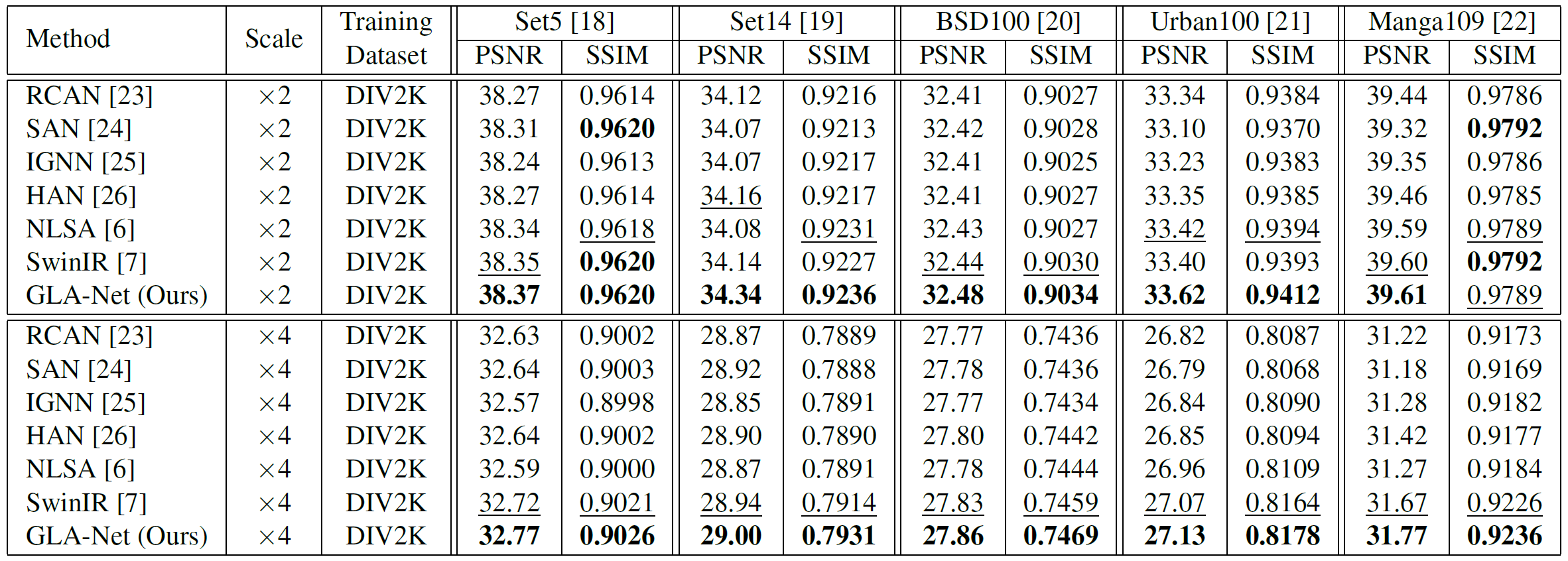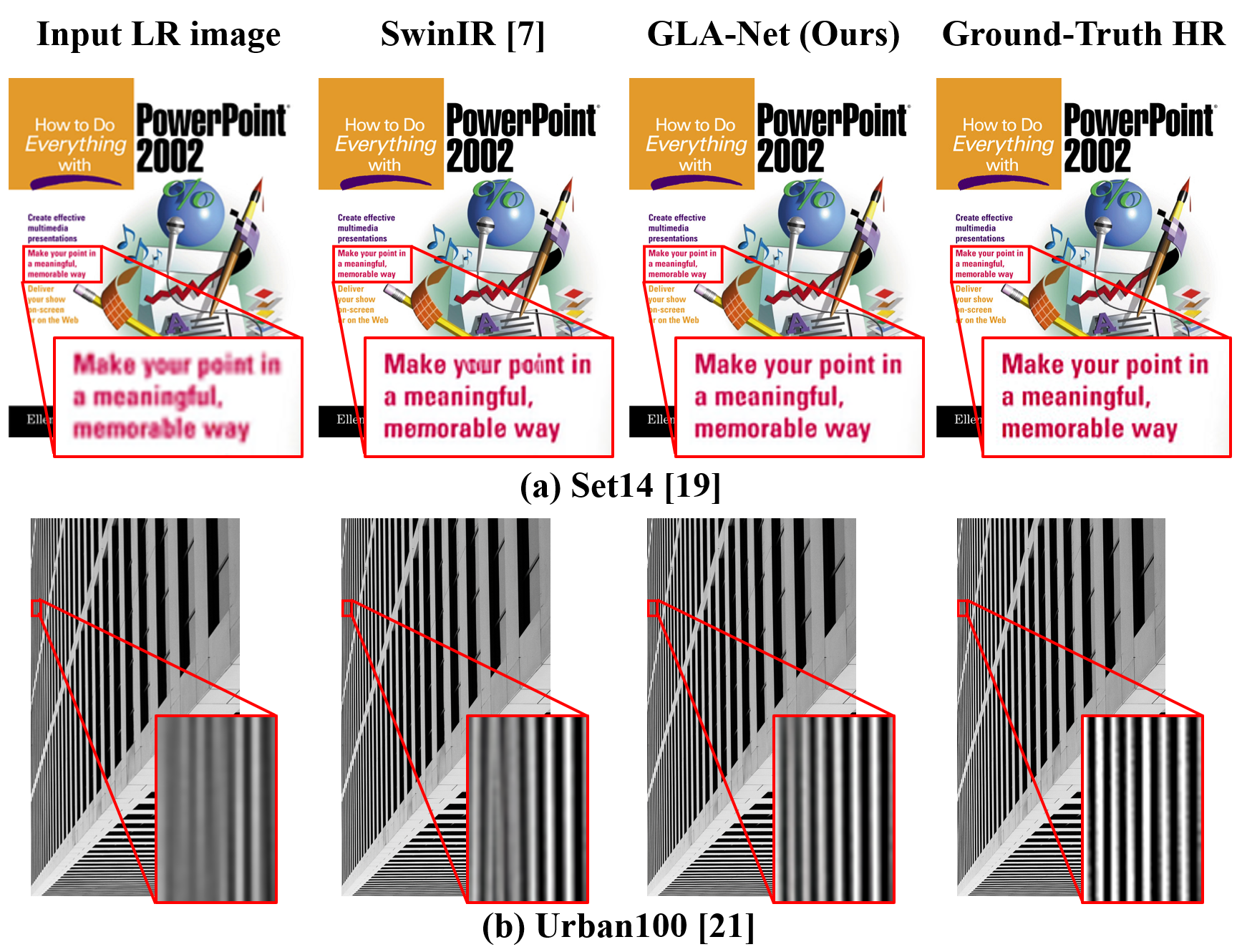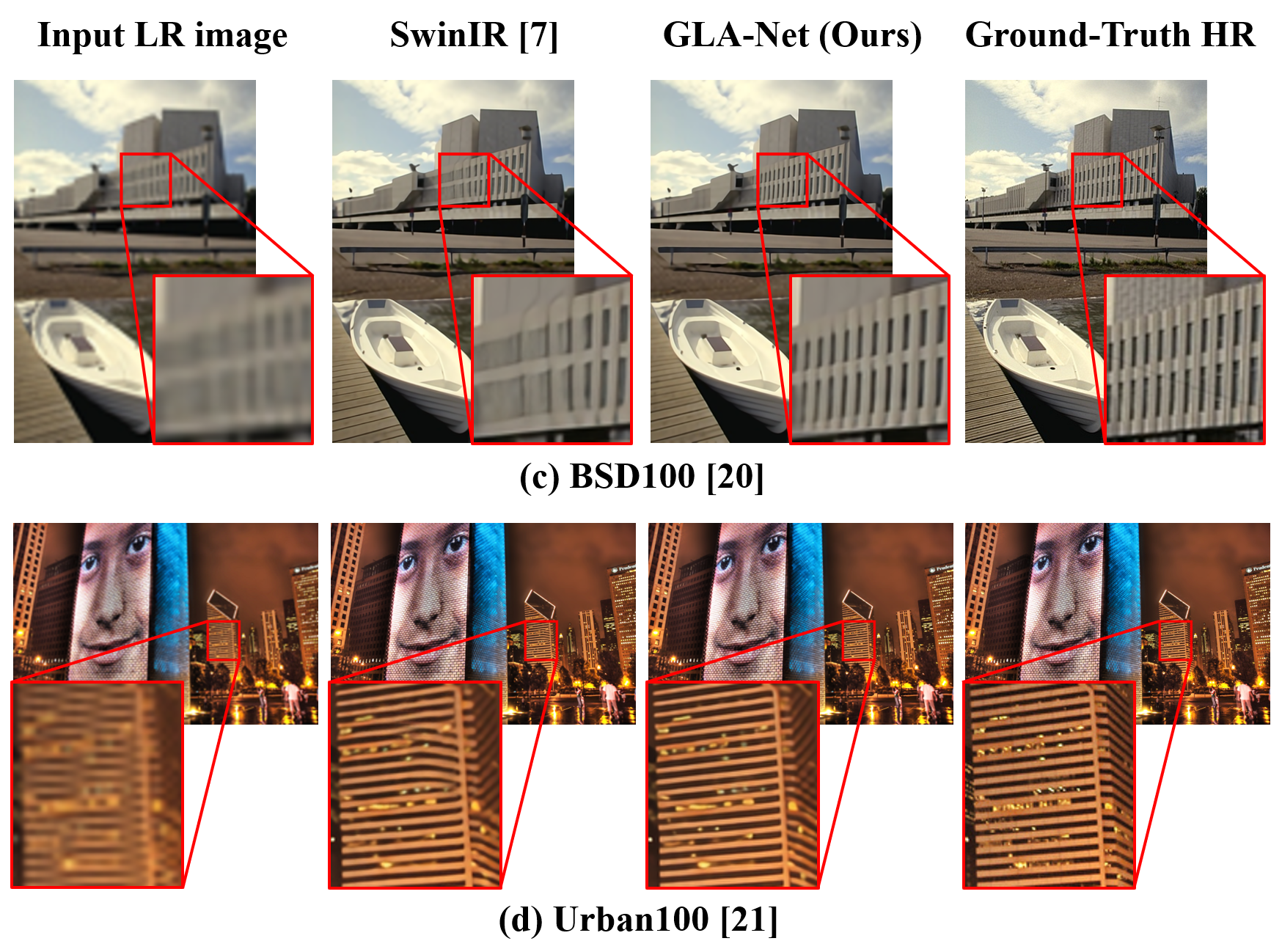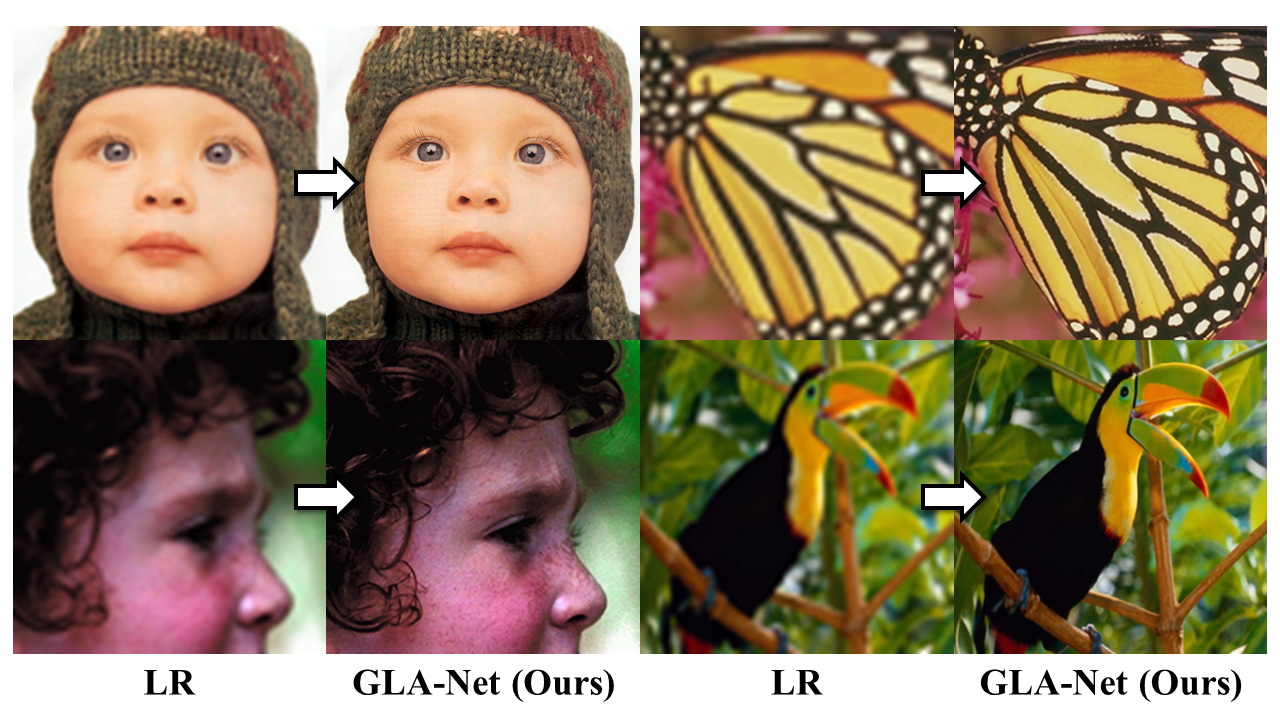References
[1] Wilman W. W. Zou and Pong C. Yuen, “Very low resolution face recognition problem,”
IEEE Transactions on Image Processing, vol. 21, no. 1, pp. 327–340, 2012.
[2] Wenzhe Shi, Jose Caballero, Christian Ledig, Xiahai Zhuang, Wenjia Bai, Kanwal Bhatia,
Antonio Marvao, Tim Dawes, Declan O’Regan, and Daniel Rueckert,
“Cardiac image superresolution with global correspondence using multi-atlas patchmatch,”
in International Conference on Medical Image Computing and Computer-Assisted Intervention (MICCAI), 2013.
[3] Mehdi S. M. Sajjadi, Bernhard Scholkopf, and Michael Hirsch,
“EnhanceNet: Single image super-resolution through automated texture synthesis,”
in IEEE International Conference on Computer Vision (ICCV), 2017.
[4] Yulun Zhang, Kunpeng Li, Kai Li, Bineng Zhong, and Yun Fu,
“Residual non-local attention networks for image restoration,”
in International Conference on Learning Representations (ICLR), 2019.
[5] Yiqun Mei, Yuchen Fan, Yuqian Zhou, Lichao Huang, Thomas S. Huang, and Honghui Shi,
“Image super-resolution with cross-scale non-local attention and exhaustive self-exemplars mining,”
in IEEE/CVF Conference on Computer Vision and Pattern Recognition (CVPR), 2020.
[6] Yiqun Mei, Yuchen Fan, and Yuqian Zhou,
“Image super-resolution with non-local sparse attention,”
in IEEE/CVF Conference on Computer Vision and Pattern Recognition (CVPR), 2021.
[7] Jingyun Liang, Jiezhang Cao, Guolei Sun, Kai Zhang, Luc Van Gool, and Radu Timofte,
“SwinIR: Image restoration using swin transformer,”
IEEE/CVF International Conference on Computer Vision Workshops (ICCVW), 2021.
[8] Ze Liu, Yutong Lin, Yue Cao, Han Hu, Yixuan Wei, Zheng Zhang, Stephen Lin, and Baining Guo,
“Swin transformer: Hierarchical vision transformer using shifted windows,”
in IEEE/CVF International Conference on Computer Vision (ICCV), 2021.
[9] Namuk Park and Songkuk Kim, “How do vision transformers work?,”
in The Tenth International Conference on Learning Representations (ICLR), 2022.
[10] Chenyang Si, Weihao Yu, Pan Zhou, Yichen Zhou, Xinchao Wang, and Shuicheng Yan,
“Inception transformer,” in Advances in Neural Information Processing Systems (NeurIPS), 2022.
[11] Christian Szegedy, Vincent Vanhoucke, Sergey Ioffe, Jon Shlens, and Zbigniew Wojna,
“Rethinking the inception architecture for computer vision,” in IEEE Conference on Computer Vision and Pattern Recognition (CVPR), 2016.
[12] Gao Huang, Zhuang Liu, Laurens van der Maaten, and Kilian Q. Weinberger,
“Densely connected convolutional networks,”
in IEEE Conference on Computer Vision and Pattern Recognition (CVPR), 2017.
[13] Ashish Vaswani, Noam Shazeer, Niki Parmar, Jakob Uszkoreit, Llion Jones,
Aidan N. Gomez, Łukasz Kaiser, and Illia Polosukhin,
“Attention is all you need,” in Advances in Neural Information Processing Systems (NeurIPS), 2017.
[14] Wenzhe Shi, Jose Caballero, Ferenc Huszar, Johannes Totz, Andrew P. Aitken,
Rob Bishop, Daniel Rueckert, and Zehan Wang,
“Real-time single image and video super-resolution using an efficient
sub-pixel convolutional neural network,”
in IEEE Conference on Computer Vision and Pattern Recognition (CVPR), 2016.
[15] Diederik P. Kingma and Jimmy Ba, “Adam: A method for stochastic optimization,”
in International Conference on Learning Representations (ICLR), 2015.
[16] Adam Paszke, Sam Gross, Soumith Chintala, Gregory Chanan, Edward Yang, Zachary DeVito,
Zeming Lin, Alban Desmaison, Luca Antiga, and Adam Lerer, “Automatic differentiation in PyTorch,”
in NeurIPS Workshop on Autodiff, 2017.
[17] Eirikur Agustsson and Radu Timofte,
“NTIRE 2017 challenge on single image super-resolution: Dataset and study,”
in IEEE Conference on Computer Vision and Pattern Recognition Workshops (CVPRW), 2017.
[18] Marco Bevilacqua, Aline Roumy, Christine Guillemot, and Marie-line Alberi Morel,
“Low-complexity single-image super-resolution based on nonnegative neighbor embedding,”
in Proceedings of the British Machine Vision Conference (BMVC), 2012.
[19] Roman Zeyde, Michael Elad, and Matan Protter,
“On single image scale-up using sparse-representations,”
in International Conference on Curves and Surfaces (ICCS), 2010.
[20] David Martin, Charless Fowlkes, Doron Tal, and Jitendra Malik,
“A database of human segmented natural images and its application to
evaluating segmentation algorithms and measuring ecological statistics,”
in Proceedings Eighth IEEE International Conference on Computer Vision (ICCV), 2001.
[21] Jia-Bin Huang, Abhishek Singh, and Narendra Ahuja,
“Single image super-resolution from transformed self-exemplars,”
in IEEE Conference on Computer Vision and Pattern Recognition (CVPR), 2015.
[22] Yusuke Matsui, Kota Ito, Yuji Aramaki, Azuma Fujimoto, Toru Ogawa,
Toshihiko Yamasaki, and Kiyoharu Aizawa,
“Sketch-based manga retrieval using manga109 dataset,”
Multimedia Tools and Applications, vol. 76, pp. 21811-21838, 2017.
[23] Yulun Zhang, Kunpeng Li, Kai Li, Lichen Wang, Bineng Zhong, and Yun Fu,
“Image super-resolution using very deep residual channel attention networks,”
in European Conference on Computer Vision (ECCV), 2018.
[24] Tao Dai, Jianrui Cai, Yongbing Zhang, Shu-Tao Xia, and Lei Zhang,
“Second-order attention network for single image super-resolution,”
in IEEE/CVF Conference on Computer Vision and Pattern Recognition (CVPR), 2019.
[25] Shangchen Zhou, Jiawei Zhang, Wangmeng Zuo, and Chen Change Loy,
“Cross-scale internal graph neural network for image super-resolution,”
in Proceedings of the 34th International Conference on Neural Information Processing Systems (NeurIPS), 2020.
[26] Ben Niu, Weilei Wen, Wenqi Ren, Xiangde Zhang, Lianping Yang, Shuzhen Wang,
Kaihao Zhang, Xiaochun Cao, and Haifeng Shen,
“Single image super-resolution via a holistic attention network,”
in European Conference on Computer Vision(ECCV), 2020.







